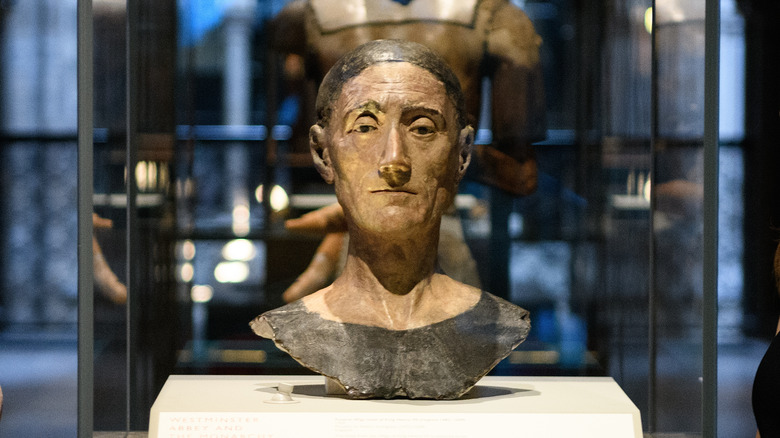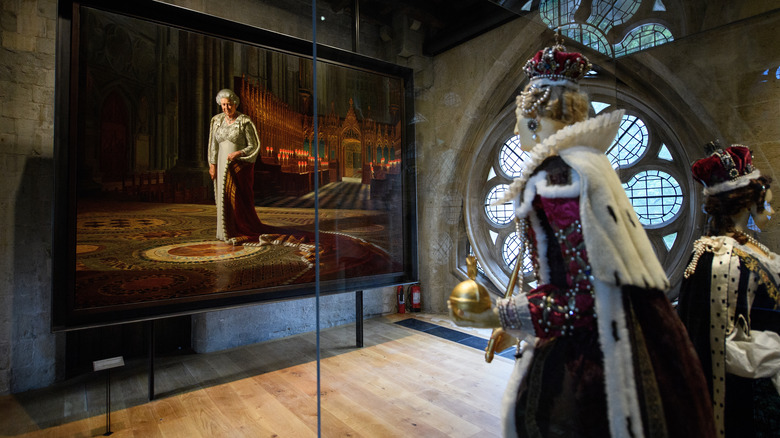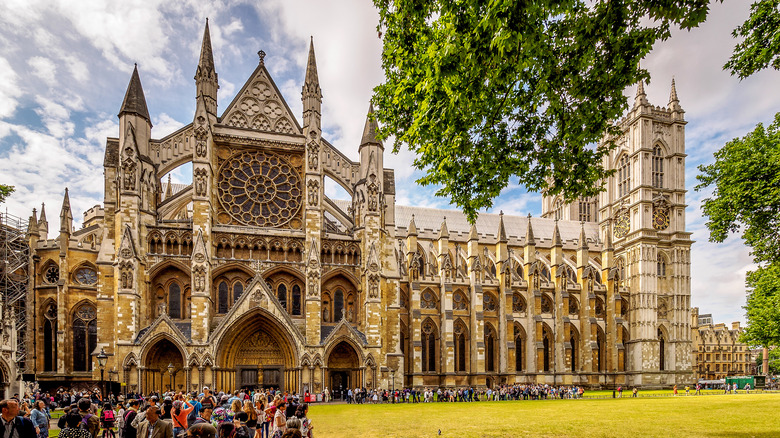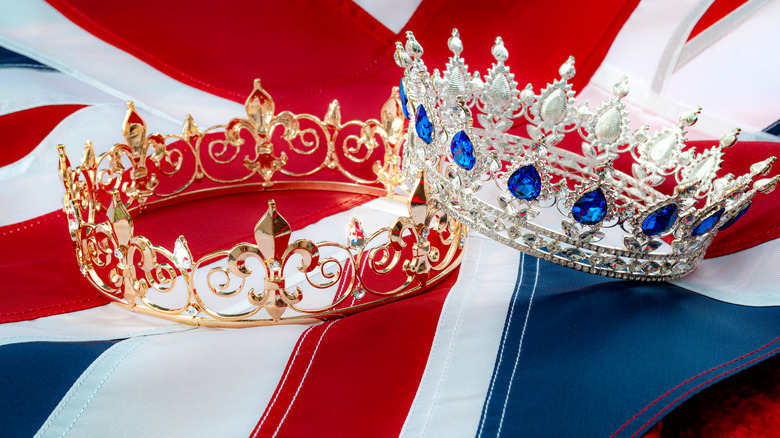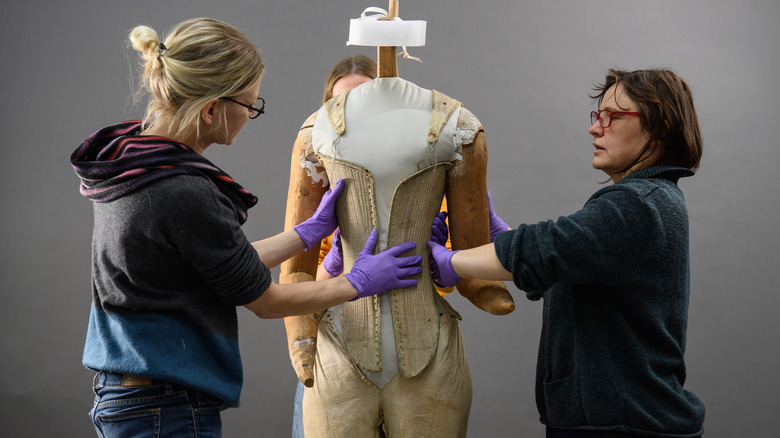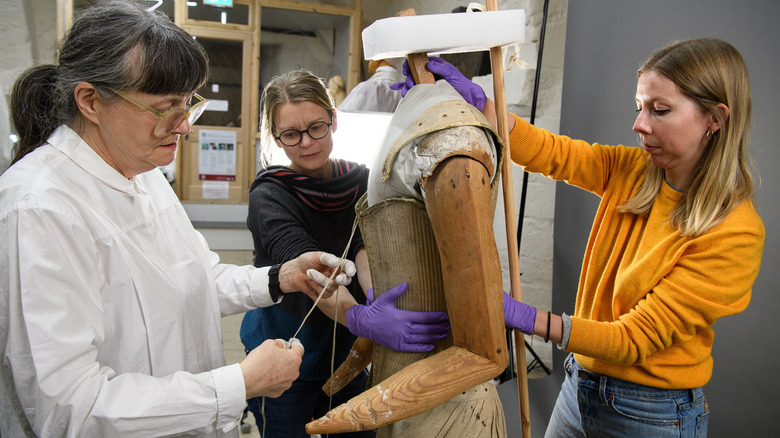The History Of The Funeral Effigies In Westminster Abbey
Many countries and cultures throughout history have had their own customs for honoring the deceased. As ThoughtCo explains, burial rituals and rites go back tens of thousands of years in the past. Many early customs had the express purpose of not upsetting spirits, often believed to be the reason for an individual's death. This had significant overlap with religious beliefs as well. In fact, many of today's funeral practices, such as funeral bells and gun firing, came from these early superstitions.
With the passing of Queen Elizabeth II, the United Kingdom is currently undergoing its period of mourning and preparing funeral processions. The deaths of British monarchs each have their own special history, but one strange thing that people might not know about is funeral effigies. As said by the Westminster Abbey website, the gallery is home to 20 wax and wooden effigies. But why do they exist? And what is their purpose?
What are funeral effigies?
There are many different types of effigies that are made for different purposes. As Encyclopedia.com says, an effigy is essentially the likeness of an individual, usually made as a representation or symbol of the person. Often, effigies were evoked to create a remembrance of people who've passed away. This practice goes back to antiquity, and many cultures and groups have done it. The Etruscans, for example, often created very lifelike effigies of their own as far back as the fifth century B.C.
The practice was incredibly popular in most of Europe, with the art itself growing in technical proficiency and esteem. England was particularly fond of this art form, as many royal monarchs had effigies fashioned for them. As the Westminster Abbey website says, monarchs such as Elizabeth I, Mary I, Henry VII, Anne of Bohemia, James I, and more had effigies crafted for them, and they now reside in the royal galleries.
Why are there effigies in Westminster Abbey?
Some of the most striking effigies in the world reside in Westminster Abbey's hallowed halls. As the Westminster Abbey website says, the tradition of funeral effigies being used in royal funerals all started in the 13th century. The first reported effigy of a monarch was Edward III's from 1377, the year he died, and it has a death mask sculpted into it. These effigies were often made from wood, wax, and other soft materials and have been kept protected for centuries. During World War II, some effigies were damaged, though they were eventually repaired.
As Museum Crush explains, these effigies are kept in the Queen's Diamond Jubilee Galleries and are available for public viewing. These galleries are also home to many other British treasures, some of which date back a thousand years ago. After these effigies have served their ceremonial purposes, they are then kept behind glass for anyone to experience a piece of history.
Whose effigies are in the Westminster Abbey gallery?
As most of the effigies were originally made for monarchs, all of them capture the likeness of royalty set in wood and wax. Queen Elizabeth I's effigy is among the ones in the gallery (via Westminster Abbey). Queen Elizabeth I was one of the most well-known British monarchs and was one of King Henry VIII's children. As it is known, the Elizabethan era produced some of the most notable culture events in British history, such as the works of William Shakespeare. Even though her effigy was made in 1603, a remake was fashioned in 1760, with new clothes and waxy features.
As Museum Crush says, effigies of other monarchs — like Catherine, Duchess of Buckingham, Henry VII, Mary I, Queen Anne, Edward III, Catherine de Valois, Elizabeth of York, and more — also reside in the galleries. These effigies often came with regal clothing, worn since their creation, but some of these pieces have either been damaged or lost. And though many effigies have been damaged, there have been numerous conservation efforts over many centuries.
How are the effigies conserved?
Given the enormous ceremonial importance and historical weight of these effigies, there has been a lot of conservation effort in preserving them. As Westminster Abbey explains, many of these effigies have either been damaged through war or the passage of time or have disappeared entirely. What is on display today is not the full collection of effigies made, and some of what exists now only does so in fragments. R.P. Howgrave Graham, a historian who died on March 25, 1959, tasked himself with restoring all of the effigies damaged during World War II, including those of Edward III and Henry VII.
As Museum Crush says, there is a team of textile conservators responsible for preserving the effigy clothes. As clothing is often subject to degradation and rot over time, pieces of royal clothing, with all of their delicacies, need attentive care to look their best. Zenzie Tinker, the head of the textile conservation effort, explains parts of this labor. "We carefully undressed each effigy, slowly peeling back layers of clothing which have been hidden from view for years," she told Museum Crush.
Effigy clothing has its own interesting history
While the effigies themselves are spectacular remnants of history, the pieces of clothing that they were adorned with tell their own stories. As The Guardian explains, the clothing on the effigies reflects the eccentricities of the monarchs whose likeness they capture. Many of these clothes are quite rare and provide staggering archeological insight into how aristocrats and monarchs dressed themselves during their respective time periods. For example, Charles II's effigy was adorned with crimson and blue velvet garter robes. This robe also had gold threads, silver lace embroidery, silk ribbons, and other breathtaking adornments, making it an exceedingly valuable treasure.
As Museum Crush says, many of the other effigies contained the same level of extravagant decadence. Even the effigies of child aristocrats and monarchs were fashionably dressed. Robert, Marquis of Normanby, was just 3 years old when he died, yet his effigy is adorned with some of the most expensive 18th-century clothes. A cerise velvet robe, long-sleeved gold threaded waistcoat, brocade sash, lace cuffs, and more adorn the effigy's body. Even something as innocuous as clothing can tell a full story about who someone was when they were alive.
